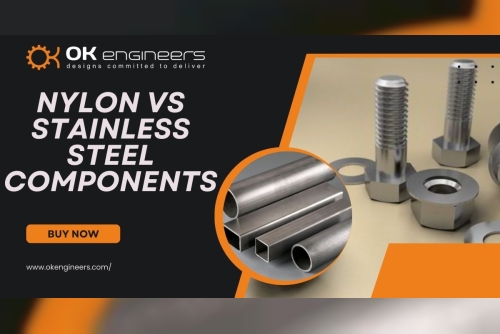Introduction
In manufacturing and engineering, material selection plays a pivotal role in ensuring efficiency, durability, and cost-effectiveness. The debate of Nylon vs Stainless Steel Components is significant across industries, as these materials cater to various needs with unique strengths and applications. This article dives deep into their properties, advantages, disadvantages, and uses, helping you make an informed decision. OK Engineers, a trusted name in the field, excels in manufacturing high-quality components to meet your industrial requirements.
Nylon is a versatile synthetic polymer widely used in manufacturing due to its lightweight, flexibility, and resistance to wear and tear. It serves as an excellent alternative to metals in specific applications, offering numerous advantages.
Key Features of Nylon ComponentsLightweight Design
Nylon components are much lighter than metals, making them ideal for applications where reducing weight is essential, such as in automotive and aerospace industries.
Durability and Resilience
Nylon exhibits excellent wear resistance and impact strength, allowing it to endure rigorous conditions without compromising functionality.
Low Friction Coefficient
Its smooth surface and low friction properties make it suitable for applications like gears, bushings, and bearings, where reducing wear is crucial.
Cost-Effectiveness
Compared to stainless steel components, nylon parts are more affordable to produce and replace, making them an economical choice for non-structural applications.
Corrosion Resistance
Nylon does not rust or corrode, which makes it ideal for environments with high humidity or exposure to chemicals.
Stainless steel components are synonymous with strength, durability, and resistance to extreme conditions. These parts are extensively used in industries that demand robust materials capable of withstanding high pressure and temperatures.
Key Features of Stainless Steel ComponentsSuperior Strength
Stainless steel is renowned for its tensile strength, making it suitable for heavy-duty applications in construction, marine, and industrial machinery.
Corrosion Resistance
One of the primary reasons stainless steel parts are preferred is their resistance to rust and corrosion, especially in harsh or wet environments.
Heat Resistance
Stainless steel maintains its integrity even at high temperatures, making it an excellent choice for components exposed to thermal stress.
Aesthetic Appeal
The sleek and polished look of stainless steel adds an aesthetic advantage, particularly in consumer-facing products such as kitchen appliances and decorative elements.
Longevity
Despite its higher initial cost, stainless steel components offer long-term value by requiring minimal maintenance and providing a long service life.
Automotive Industry
Nylon components like cable ties, clamps, and gears are commonly used due to their lightweight and durable nature.
Electronics
Its insulating properties make nylon an excellent choice for circuit board spacers and connectors.
Packaging
Flexible and strong, nylon is used in food-grade films and containers.
Construction
From beams to fasteners, stainless steel parts are essential in buildings and infrastructure.
Healthcare Equipment
Its non-reactive and easy-to-clean nature makes stainless steel indispensable in surgical instruments and medical devices.
Food Processing
Stainless steel is widely used in kitchenware, food storage tanks, and processing equipment due to its hygienic properties.
When it comes to precision-engineered components, OK Engineers stands out as a leader in delivering exceptional quality. Whether you need durable stainless steel components or lightweight nylon parts, the company provides customized solutions tailored to meet your industrial demands. With cutting-edge technology and a commitment to excellence, OK Engineers ensures every product adheres to global standards.
ConclusionChoosing between "Nylon vs Stainless Steel Components" boils down to your specific needs and the environment in which the components will be used. Nylon is perfect for applications that prioritize weight, flexibility, and cost-efficiency, while stainless steel shines in strength, durability, and resistance to extreme conditions. Both materials have distinct advantages, and the final choice depends on the intended application. For high-quality components tailored to your needs, OK Engineers is your trusted partner in innovation and excellence.









 Fortinet NSE 4 – FortiOS 7.6 Administrator NSE4_FGT_AD-7.6 Dumps
Fortinet NSE 4 – FortiOS 7.6 Administrator NSE4_FGT_AD-7.6 Dumps


